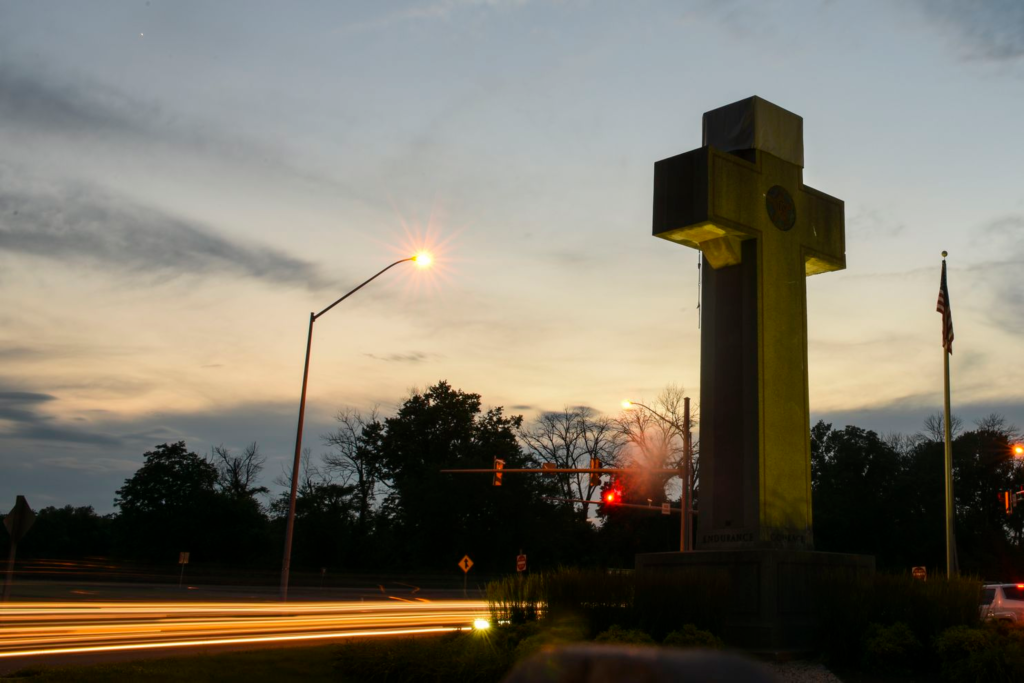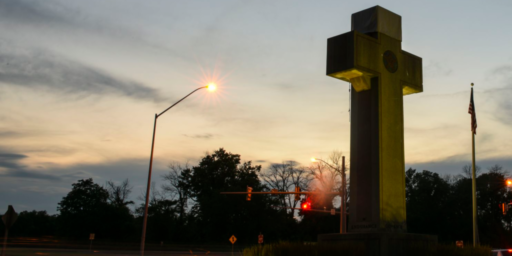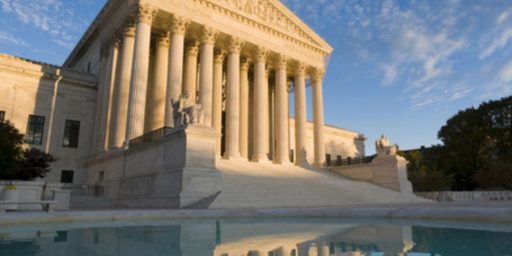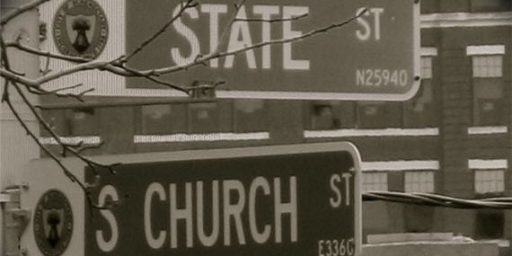Supreme Court Holds That Maryland Peace Cross Can Stay On Public Land
The Supreme Court ruled that a World War One memorial that had been on public grounds for 70 years can stay where it is.

In what amounted to the highest-profile religious freedom case of this term, the Supreme Court ruled in a 7-2 decision that includes several concurring opinions that a World War One memorial on public land in a suburban Maryland neighborhood does not violate the Establishment Clause:
The Supreme Court ruled Thursday that a 40-foot cross erected as a tribute to war dead may continue to stand on public land in Maryland, rejecting arguments that it was an unconstitutional endorsement of religion.
The vote was 7 to 2, but the ruling prompted an outpouring of individual opinions as the court struggled to explain what should be done with public displays that feature religious imagery.
Justice Samuel A. Alito Jr. wrote the main opinion and said history and tradition must be taken into account when judging modern objections to monuments on public land.
“The cross is undoubtedly a Christian symbol, but that fact should not blind us to everything else that the Bladensburg Cross has come to represent,” Alito wrote. “For some, that monument is a symbolic resting place for ancestors who never returned home. For others, it is a place for the community to gather and honor all veterans and their sacrifices for our Nation. For others still, it is a historical landmark.
“For many of these people, destroying or defacing the Cross that has stood undisturbed for nearly a century would not be neutral and would not further the ideals of respect and tolerance embodied in the First Amendment.”
Alito was joined in deciding that the cross may remain by Chief Justice John G. Roberts Jr. and Justices Clarence Thomas, Stephen G. Breyer, Elena Kagan, Neil M. Gorsuch and Brett M. Kavanaugh.
Justices Ruth Bader Ginsburg and Sonia Sotomayor dissented, and Ginsburg emphasized her disagreement by reading part of her dissent from the bench. She said the court’s decision to maintain the cross-shaped monument on public land “erodes” the constitutional principle that “demands governmental neutrality.”
By honoring World War I soldiers with a cross-shaped memorial, the state of Maryland, she said, “places Christianity above other faiths” and sends the message to people of other faiths that “they are outsiders.”
“Making a Latin cross a war memorial does not make the cross secular. Quite the contrary, the image of the cross makes the war memorial sectarian. The Peace Cross is no exception,” Ginsburg said.
Amy Howe has a more detailed summary of the decision at SCOTUSBlog:
The ruling is the latest chapter in the debate over religious symbols in the public sphere. The justices confronted a similar case nearly 15 years ago, when they rejected a challenge to the display of a Ten Commandments monument on the grounds of the Texas state capitol. In that case, Justice Stephen Breyer provided the fifth vote to leave the monument in place, with his concurring opinion providing the governing rule. In 1971, the Supreme Court outlined a test – known as the “Lemon test,” after the case in which it was established, for courts to use to determine whether a law or practice violates the establishment clause: The law or practice is constitutional if it has a secular purpose, its principal effect does not advance or inhibit religion, and it does not create an “excessive entanglement with religion.”
But Breyer declined to use the Lemon test in the Texas case, explaining that there is “no single mechanical formula that can accurately draw the constitutional line in every case.” Breyer reasoned that although the Ten Commandments monument “undeniably has a religious message,” the state intended it to convey a secular message. Indeed, Breyer noted, no one had challenged the presence of the monument at the capitol for 40 years – which, he posited, suggested that the public regards it as part of a “broader moral and historical message reflective of a cultural heritage.”
Justice Samuel Alito wrote for the court today, in an opinion that once again eschewed the use of the Lemon test. Alito began by explaining that although the cross “came into widespread use as a symbol of Christianity” and continues to have that meaning today, it “has also taken on a secular meaning” in other contexts. In particular, Alito noted, the cross became a “central symbol” of World War I – which likely explains the choice to use a massive cross as the memorial for the Prince George’s County soldiers.
Alito then reasoned that in cases involving longstanding religious memorials or symbols, the Lemontest should not apply. At least when the question is whether to keep them in place, rather than to put up new ones, Alito emphasized, there should be a presumption that they are constitutional.
That presumption, Alito continued, applies here: Not only did the cross start off with the “added secular meaning” associated with World War I, but it took on “historical importance”: It reminds local residents of the conflict and the sacrifices that area soldiers made. On the other hand, there is no evidence that Jewish soldiers were either “deliberately left off the list on the memorial” or “included on the Cross against the wishes of their families.”
“The cross is a Christian symbol,” Alito concluded, “but that fact should not blind us to everything else that the Bladensburg Cross has come to represent. For some, that monument is a symbolic resting place for ancestors who never returned home,” while for others “it is a place for the community to gather and honor all veterans and their sacrifices for our Nation.” “For many of these people,” Alito stressed, “destroying or defacing the Cross that has stood undisturbed for nearly a century would not be neutral and would not further the ideals of respect and tolerance embodied in the First Amendment.”
Alito’s majority opinion was joined by several concurring opinions that agreed with the outcome of the case but either did so for other reasons or because there is a point of law that they wanted to raise not fully fleshed out in the majority opinion. In this case, the most notable concurrences came from Justice Gorsuch and Justice Thomas.
In Justice Gorsuch’s case, he argues that the case should have been dismissed because the parties that brought the case did not have standing to do so. He described their position as being the fact that they were “offended” by the presence of a cross on public land and argued that being offended is not sufficient ground to establish standing to sue in a Federal Court. Gorsuch’s opinion does not foreclose the possibility that someone might have standing to bring a lawsuit, but it does not definitively state what kind of person might have standing.
In Justice Thomas’s case, he relies on his long-standing position that the Establishment Clause of the First Amendment should not apply to the states. This is an argument that is inconsistent with existing court precedent, but it is one that Thomas has held onto for much of his time on the Court. It’s notable, though, that none of the other conservative Justices, including the late Justice Scalia, have agreed with this position or signed on to a concurring or dissenting opinion in which Thomas has stated this position.
The sole dissent in the case was written by Justice Ruth Bader Ginsburg, who was joined by Justice Sonya Sotomayor. In her opinion, Ginsburg rejects the majority argument that the cross did not have a specific religious meaning behind it, noting for example that “The Latin Cross, is the foremost symbol of the Christian faith,” and that the fact that it was intended to be a war memorial rather than a statement or endorsement of religious faith. Ginsburg goes on to argue that by keeping and “maintaining the Peace Cross on a public highway,” the state and county government “elevates Christianity over other faiths, and religion over nonreligion.” Her opinion went on to note that the cross is not just a generic war memorial by pointing out that, in military cemeteries, the graves of non-Christian service members are not memorialized with a cross but with a symbol of their own faith, such as the Star of David for Jewish veterans and the crescent moon for Muslim veterans. In this respect, it should be noted that Ginsburg’s late husband, Martin Ginsburg, was himself a Jewish-American veteran, although his years of service began after the end of the Korean War and before the beginning of the Vietnam War.
While the Court’s opinion here is somewhat muddled due to the fact that there are five concurrences, it appears that, for the most part, the majority has adhered to long-standing precedent that has held that some government recognition of religion is acceptable in part because it is, at the most, a de minimus example of such action. By this I mean that while the action being complained of, which can range from things such as “In God We Trust” on coins and currency to more serious cases such as this, do include some reference to religious faith it is, at best, a generic reference that is not intended to promote any specific faith or belief, nor is it intended to disparage any other faith or belief.
The most notable example of what a de minimus recognition of religion, of course, can be found in the cases dealing with the issue of prayers before the opening of a legislative session. That issue first came up in a 1983 Supreme Court case called Marsh v. Chambers in which a member of Nebraska’s unicameral state legislature challenged the constitutionality of both the practice of opening each day’s session with a prayer and the fact that the state was paying for the chaplain with taxpayer dollars. The U.S. District Court Judge that first heard the case held that an opening prayer did not violate the Constitution, but that state support for the position and the office did. On appeal, the Eighth Circuit Court of Appeals ruled that both practices were unconstitutional due to the fact that they violated the Establishment Clause of the First Amendment. In its opinion, the Supreme Court overruled the Eighth Circuit in a 6-3 ruling that relied mostly on history much like the majority opinion in this case. Instead, the Court essentially said that, like the practice of putting “In God We Trust” on currency, the practice of having a chaplain deliver prayers at the start of a legislative session, and making that a position paid for out of taxpayer funds, was at best a de minimis violation of the Establishment Clause.
The issue came up again in 2014 in Town of Greece v. Galloway where the Supreme Court dealt with the practice by the town of Greece, New York to open each meeting of its Council with a prayer, a practice that was challenged by a town resident assisted by civil liberties organizations. In a 5-4 ruling, the Court sided with the town and largely followed the precedent set in Marsh. As I noted at the time the court accepted the case, this seems like the ideal ruling in a case like this:
Some government practices that reference religion, I would argue, fall into a de minimis category where it’s recognized that some practices are essentially so harmless that they ought to be permitted as a general rule so long as they don’t become overtly sectarian. One example of that is the whole issue of the inclusion of the words “Under God” in the Pledge of Allegiance, or the appearance of “In God We Trust” on paper currency and coins. As a general rule, there doesn’t seem to me to be anything inherently coercive about either practice. Nobody, including schoolchildren, is legally required to recite the Pledge, and nobody can be legitimately punished for refusing to do so, or for refusing to say “Under God” if they day. Similarly, while we all use coins and paper bills at some point, I doubt anyone pays much attention to what’s written upon them beyond the denomination. Lawsuits challenging both of these practices have been routinely rejected by Federal Courts in no small part because of these facts.
As a general rule, I’d suggest that the idea of opening a legislative session with a prayer falls into this de minimis category in most cases. The prayers that open the House and Senate, for example, are usually fairly general to the point where they can’t be said to be representative of any particular religious tradition beyond, of course, an appeal to a God of some kind. It’s also worth noting, as the Supreme Court did in Marsh, that the practice of opening a legislative session with some kind of prayer has a long history in the United States. Indeed, at one point during the Convention of 1787 when delegates found themselves at an impasse over the drafting of the Constitution, it was Benjamin Franklin, who was, at best, a Deist, who suggested that the body engage in a short prayer.
Additionally, the Supreme Court itself opens with the appeal that “God save the United States and this Honorable Court.” Given that history, it seems difficult to argue that those who drafted and ratified the First Amendment intended to ban a practice they themselves engaged in both before and after the Bill of Rights were ratified. Of course, this whole issue becomes arguably problematic when you’re talking about the fact that there are atheists and agnostics in the world, I’m not entirely convinced of the argument that the practice in and of itself is so inherently wrong that it ought to be prohibited for this reason alone. And I say this as someone who considers themselves to be an atheist.
This isn’t the first case of its type that the Supreme Court has taken up. In Salazar v. Buono 559 U.S. 700 (2010), the Court dealt with a war memorial called the Mojave Memorial Cross that was erected by the Veterans of Foreign Wars in a National Park in the Mojave desert in 1934. Since the cross was on Federal land, the Plaintiffs in that case, much like the Plaintiffs in this Maryland case, argued that permitting it to stay amounted to an impermissible government endorsement of Christianity in violation of the First Amendment. In a divided opinion, the Justices ended up with a ruling that allowed the cross to stay on Federal property but which also remanded the case to the lower courts for resolution of other issues. To this day, it appears that those issues remain unresolved, but the memorial cross remains standing.
Because of the divisions in the court, there was no clear-cut majority opinion even though the majority result allows the cross to remain standing. In a plurality opinion that was joined by Chief Justice Roberts and Justice Alito, though, Justice Kennedy stated that “A Latin cross is not merely a reaffirmation of Christian beliefs,” he wrote, “It evokes thousands of small crosses in foreign fields marking the graves of Americans who fell in battles, battles whose tragedies would be compounded if the fallen are forgotten.” Finally, in holding that not every apparent use of religious symbolism by or on government property, Kennedy stated that “The goal of avoiding governmental endorsement [of religion] does not require eradication of all religious symbols in the public realm.” In his dissent, though, Justice John Paul Stevens rejected Kennedy’s take on the issue. Instead, he argued that”[t]he cross is not a universal symbol of sacrifice….It is the symbol of one particular sacrifice, and that sacrifice carries deeply significant meaning for those who adhere to the Christian faith.”
On the whole, I think that the Justices got this issue right, in result if not necessarily in reasoning. It seems clear that the original intent of the cross was to memorialize the sacrifices of local men who had died in World War One, many of whom were buried overseas rather than having their remains returned to the United States for burial. While the memorial itself is in the shape of a cross, there doesn’t seem to be anything specifically religious about it, and that it was not intended to promote any specific religious belief other than a generic statement of public faith and instead was intended to memorialize what amounted to America’s first real overseas war. As such, it is both the kind of de minimus expression of religious belief represented by the legislative prayer cases and the appeals to history that are mentioned in both today’s opinion and the court’s opinion in the aforementioned Salazar case. Perhaps if the cross had not been in place for the past 70 years with little to no complaint this might be a different case, but that’s not the case here.
Here’s the opinion:
American Legion v. American… by on Scribd




Doug, I think the Court got it wrong in much the same way you get it wrong in this quote:
It isn’t that the individuals who erected the cross “intended to promote” Christianity. It is that they couldn’t conceive of a community that wasn’t Christian. I’m pretty sure they weren’t malicious in their choice but “merely” thoughtless. However, intent doesn’t matter. Actions do. And their action of using a Christian symbol isn’t without cost to the non-Christians who see it. It conveys a very real message that that the “norm” is Christian and that those non-Christian citizens aren’t part of it. And that is precisely what the First Amendment is designed to prevent – treating members of a particular religion, or no religion, as different classes of citizenship.
Oh, and being a cross, in an of itself, it is inherently religious. There is no non-religious use of a cross. That is inane.
Simple solutions are often best. the beef here is that the Christian cross is on public land. Very well, see if any of the religious groups favoring the memorial can raise the money to purchase and maintain the land, and the cross, and then let it stand.
As best I can tell, neither Alito’s opinion nor any of the concurrences make use of the (to me) extremely salient fact that the cross was erected on private ground by private citizens, and that the government chose to acquire it.
I am extremely leery of the de minimus excuse, which seems designed to guarantee that routine discrimination can be protected by claiming that no specific instantaneous consequence exceeds some arbitrary threshold level of harm. This is especially important when you couple it with the criteria for legal standing to sue, which Gorsuch and Thomas would have denied here:
By this interpretation, an arbitrarily large amount of cumulative damage to individuals or to a group nevertheless does not convey standing to sue, so long as each specific immediate instance of harm can be portrayed as being below the de minimus threshold. This seems particularly relevant as the question of reparations to descendants of enslaved people is being debated.
I’ve of late been reading Bruce Gibney’s The Nonsense Factory. In an interview at LGM Gibney observed,
From above, here’s the Lemon Test,
If anyone knew what that meant, this Maryland case would never have reached the Supreme Court.
I’m so far not overly impressed with Gibney’s book, but he’s sure right about the above.
As Doug said, “On the whole, I think that the Justices got this issue right, in result if not necessarily in reasoning.” Is there any way in which this decision clarifies the rules?
“The cross is undoubtedly a Christian symbol, but that fact should not blind us to everything else that the Bladensburg Cross has come to represent,” Alito wrote. “For some, that monument is a symbolic resting place for ancestors who never returned home. For others, it is a place for the community to gather and honor all veterans and their sacrifices for our Nation. For others still, it is a historical landmark.
LMAO…having a cross there is fine, but whenever people rhapsodize about how the written word of the law matters and nothing else, point to this piece of total bullshit written by somebody who wouldn’t blink about executing an innocent person if the law demanded it.
We see that the Supremes also engage in sausage making. The rational is ugly, but the result reasonable and @Kathy: is right in her solution.
@Modulo Myself: Alito conveniently ignores that *all* of the people who hold those meanings about that cross are themselves Christian.
Ginsburg’s dissent eviscerates, using actual historical records and facts the misty haze Alito’s opinion tries to place over the cross.
And actually, Part II of Kavanaugh’s concurrence is very good as well.
@SKI:..There is no non-religious use of a cross.
You got that right!
Speaking as an atheist, I can only say “Horseshit” to the above. “In God We Trust” specifically promotes religion and even more so monotheistic religion. There is NO other way to interpret that statement. Religious people, and here I speak mostly of Christians because I know far more of them than I do of other faiths, take it for granted that they are the rule, that people of other faiths must sit in the back of the bus and atheists like me? We don’t even exist.
Every Thanksgiving we have dinner with our daughter and her inlaws, all of whom are very religious. Every year she asks her FiL to give the blessing. It never occurs to any of them to even ask if I might like to because in their minds atheists don’t qualify. I don’t take it personal, and if they asked I would probably just propose to skip it all together, but the fact of the matter is, they think I am less. They aren’t even aware of that fact, but they do.
It doesn’t have to be a religious organization, Sleeping Dog and Kathy, just a private one.
@SKI:
The concurrence from Gorsuch and Thomas is actually worse. It basically asserts that a state preference for a given religion (which just happens to be Christianity) is not a violation of the Establishment Clause if the preference is traditional. That somehow makes it just a matter of custom, rather than religion, so STFU you non-Christians.
Mild insult to non-christans #300 billion. SSDD.